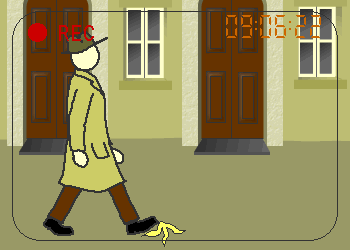
The passé composé is often used to describe a series of completed events. Because the passé composé indicates a starting point and an ending point, actions told in the passé composé move forward in time. In a story they advance the narrative.
|
Le jeune homme a glissé sur une peau de banane. Il s'est
cassé la jambe. Son chapeau est tombé sur le trottoir.
Quatre enfants ont commencé à rire. Une gentille étudiante
l'a aidé et l'a emmené à l'hôpital. |
The events can be summarized as follows:
9:06 a.m. and 22 seconds: man slips on banana skin
9:06 a.m. and 24 seconds: man breaks leg on sidewalk
9:06 a.m. and 25 seconds: man's hat lands on sidewalk
9:06 a.m. and 27 seconds: 4 children begin to laugh
9:07 a.m. and 03 seconds: kind student helps man
9:09 a.m. and 43 seconds: student takes man to hospital
9:16 a.m. and 16 seconds: student and man arrive at hospital, etc.
With each action the plot moves forward in time, even if just a few seconds. By the end, 9 minutes and 54 seconds have passed.
Because of this progression in time, if you were to record these events visually, you would need a camcorder.

Because the imparfait has no starting point or ending point, actions told in the imparfait do not advance the narrative. They add more information, more description about the same point of time. They are like a slice of life, describing simultaneous actions on a given day (or in a given year, or at a given second, etc.), and past states or past situations.
|
Le jeune homme a glissé sur une peau de banane. La peau de banane
était jaune, et sentait le frais. Le jeune homme s'est cassé la jambe. Elle lui faisait
mal, très mal. Son chapeau est tombé sur le trottoir. Il était mouillé
et sale. |
The events can be summarized as follows:
9:06 a.m. and 22 seconds: man slips on banana skin
(at that time
- 9:06 a.m. and 22 seconds - the banana skin was yellow and smelled fresh)
9:06 a.m. and 24 seconds: man breaks leg on sidewalk
(at the time
his femur fractured - 9:06 a.m. and 24 seconds - he was feeling much pain)
9:06 a.m. and 25 seconds: man's hat lands on sidewalk
(when it landed
- 9:06 a.m. and 25 seconds - it was wet and dirty)
Each of the situations described by the imparfait was true at the time mentioned. They may have been true before, and they may be true after as well, but we cannot vouch for that.
A traditional camera taking still shots would be most useful for recording actions in the imparfait.
[still picture]
(Regarde cette photo ! Cette jeune étudiante-là, c'est moi. Et ce jeune homme-là, c'est ton père. C'est le jour où nous nous sommes rencontrés pour la première fois. Moi, j'allais au travail et j'admirais le jeune homme à l'autre côté de la rue. Quand le photographe a fait cette photo, le jeune homme glissait sur une peau de banane. Et regarde ces quatre enfants ! Ils riaient comme des baleines. C'est eux qui étaient responsables de la peau de banane. Le pauvre ! Nous nous sommes mariés quinze jours plus tard.) (Look at this photo! That young student there, that's me. And that young man, that's your father. It was the day we first met. I was going to work and I was admiring the young man on the other side of the street. When the photographer took this photo, he was slipping on the banana skin. And look at those four kids! They were laughing their heads off. It's they who were responsible for the banana skin. The poor man! We got married two weeks later.)
Because they serve different, but complementary, purposes, the imparfait and the passé composé are nearly always used in conjunction. Nearly all stories alternate between description and narration. You need to describe a scene before you can say what happens to it. And once you've given some description, you need to say what happened.